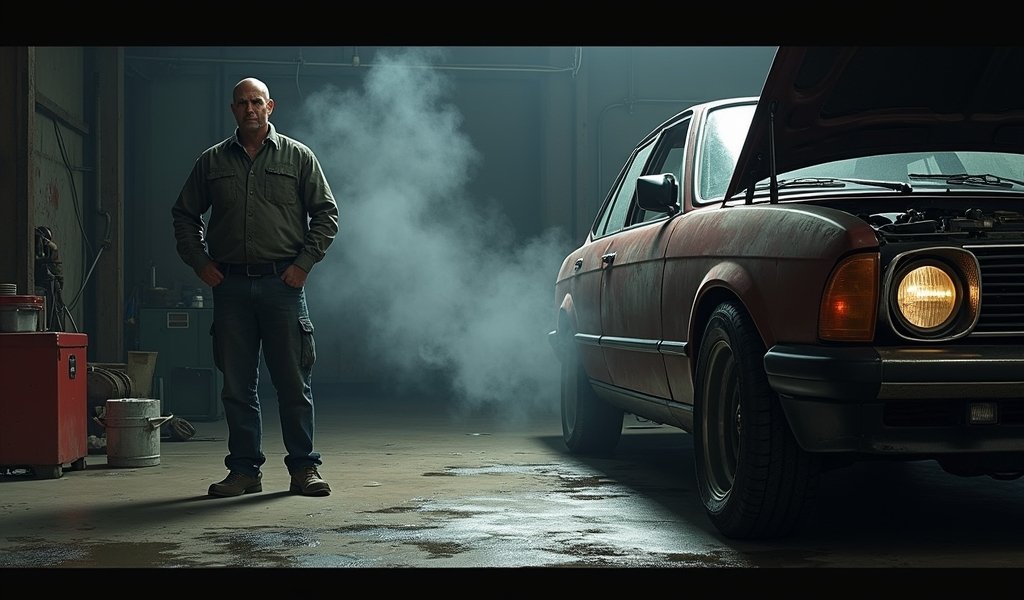Overview
The article explains how the Positive Crankcase Ventilation (PCV) system works to prevent harmful engine gases from escaping into the atmosphere, instead recycling them back into the combustion chamber while extending engine life and improving performance. It covers warning signs of PCV failure (oil leaks, rough idle, increased oil consumption), maintenance tips (inspection during oil changes, replacement every 30,000 miles), and the evolution of PCV technology from simple mechanical valves to sophisticated electronic systems in modern vehicles.
Table of Contents
- Introduction
- How the PCV System Works
- Benefits of a Healthy PCV System
- Warning Signs of PCV System Failure
- Maintenance Tips for Your PCV System
- Evolution of PCV Technology
- Conclusion
- Frequently Asked Questions
Introduction
Ah, the Positive Crankcase Ventilation system—or as we grease monkeys affectionately call it, the PCV system. It’s the unsung hero of your engine bay, quietly doing its job while flashier components get all the glory. As a mechanic who’s seen engines from the 1960s to today’s high-tech marvels, I can tell you this little gizmo is worth its weight in gold.
Picture this: Los Angeles, 1950s. The City of Angels was choking on smog so thick you could cut it with a wrench. Back then, engines simply vented their crankcase gases—a nasty cocktail of unburned fuel, water vapor, and oil mist—straight into the atmosphere through what we called “road draft tubes.” Not the brightest idea, as it turns out.
The PCV system came to the rescue as the first mandated emissions control device. By 1964, every new car sold in America had one installed. Talk about a game-changer! Instead of polluting the air, these harmful gases got recycled back into the combustion chamber for a second chance at being useful.
I’ve seen engines run for 300,000 miles with clean internals thanks to a well-maintained PCV system, and I’ve seen others turn into sludge factories when this humble component fails. As the old mechanic’s saying goes, “Small parts, big problems.”
Today, we’re going to pop the hood on everything you need to know about this vital system. Whether you’re a weekend warrior or just trying to understand what your mechanic is talking about, you’ll walk away with practical knowledge that could save your engine—and your wallet.
How the PCV System Works

Let me break down how this clever little system works, without getting too deep in the weeds of engineering speak. When your engine is running, not all the combustion is perfect. Some gases sneak past your piston rings during the combustion process—we call this “blow-by.” It’s as inevitable as taxes, especially as engines age.
These blow-by gases are bad news if left to their own devices. They’re a witches’ brew of unburned fuel, water vapor, acids, and other nasties that would love nothing more than to turn your engine oil into a thick, corrosive sludge. Before PCV systems, these gases built up pressure in the crankcase until they were forced out through seals and gaskets, causing oil leaks that would make your driveway look like an oil field.
The PCV system is elegantly simple in design but brilliant in function. Here’s the play-by-play:
- The system creates a slight vacuum in your crankcase
- This vacuum pulls harmful gases up through the PCV valve
- The PCV valve regulates flow based on engine load (it’s smarter than it looks!)
- These gases travel through a hose to your intake manifold
- They mix with fresh air and fuel before being burned in the combustion chamber
- Fresh air enters the crankcase through a breather element to replace the extracted gases
Think of it like your engine’s own recycling program. Instead of those harmful gases escaping into the atmosphere, they get a second chance to provide power. It’s like finding money in your couch cushions—you’re getting value from something that would otherwise go to waste!
The heart of the system is the PCV valve itself. This unassuming component looks simple but performs a complex balancing act. When your engine is idling, it restricts flow to maintain proper air-fuel mixtures. Under heavy acceleration, it opens wider to handle increased blow-by. And if your engine backfires? The valve snaps shut to prevent a potential crankcase explosion. That’s a lot of responsibility for a $10 part!
Modern systems often include oil separators or catch cans that trap oil mist before it can enter the intake system. This refinement helps prevent carbon buildup on intake valves—a common issue in today’s direct-injection engines that can lead to expensive repairs down the road.
As research from the EPA shows, even these simple systems significantly reduce hydrocarbon emissions from vehicles, playing a crucial role in our efforts to combat air pollution.
Benefits of a Healthy PCV System
Let me tell you about my customer Dave. He came in with a 2010 Camry that had clocked an impressive 225,000 miles, yet the engine looked practically factory fresh inside. His secret? Religious maintenance, including regular PCV system checks. The benefits of a properly functioning PCV system go way beyond just emissions control, and Dave’s engine was living proof.
First and foremost, your engine stays cleaner internally. Without proper ventilation, moisture and fuel vapors condense inside your crankcase, contaminating your oil and forming sludge. I’ve opened up valve covers that looked like they were packed with chocolate pudding—not a pretty sight, and certainly not good for engine longevity!
Your wallet will thank you too. Here’s why:
- Extended oil life – less contamination means your oil maintains its lubricating properties longer
- Reduced carbon buildup – especially important in modern direct-injection engines
- Fewer oil leaks – by maintaining proper crankcase pressure
- Better fuel economy – proper air-fuel mixtures mean more efficient combustion
- Longer engine life – reduced corrosion and wear on internal components
Let’s talk numbers: In my 25 years turning wrenches, I’ve seen proper PCV maintenance extend engine life by 20-30% compared to neglected systems. That could mean the difference between trading in your vehicle at 150,000 miles or sailing past 200,000 with confidence.
Environmental benefits shouldn’t be overlooked either. A functioning PCV system can reduce hydrocarbon emissions by up to 20%, according to automotive emissions studies. Mother Nature appreciates your well-maintained PCV system almost as much as your engine does!
There’s also the performance angle. A clogged PCV system creates excessive crankcase pressure that can blow out seals and gaskets, leading to oil leaks and that dreaded “Check Engine” light. It can also disrupt your air-fuel ratio, causing rough idling, hesitation during acceleration, and even stalling. Nobody wants their morning commute interrupted by an engine that runs like it’s gasping for breath.
As one old-timer at my shop likes to say, “Take care of the small stuff, and the big stuff takes care of itself.” The PCV system is exactly that kind of small stuff that pays big dividends when properly maintained.
Warning Signs of PCV System Failure
Your car talks to you—you just need to know how to listen. When it comes to PCV system issues, your vehicle has several ways of waving the red flag before things get ugly.
I’ll never forget Mrs. Johnson bringing in her Buick with oil literally dripping from the undercarriage. “It just started yesterday,” she insisted, though the rainbow puddle in her usual parking spot told a different story. After a quick inspection, the culprit was clear: a completely clogged PCV system that had been building pressure for months until her gaskets finally surrendered.
Don’t be like Mrs. Johnson. Watch for these telltale signs that your PCV system is crying for help:
- Oil leaks – When blow-by gases can’t escape properly, pressure builds and pushes oil past gaskets and seals. These pesky oil leaks often start small but get worse quickly.
- Rough idle or stalling – A stuck PCV valve disrupts your engine’s carefully calibrated air-fuel mixture, causing your idle to bounce around like a kangaroo or even stall out completely.
- Increased oil consumption – If you’re suddenly adding a quart between oil changes, your PCV valve might be drawing excessive oil into the intake system.
- Sludge buildup – Pop off your oil cap and take a peek inside. Thick, mayonnaise-like deposits mean moisture is condensing in your engine—often a sign of poor crankcase ventilation.
- Whistling noises – A damaged PCV valve or hose can create a distinct whistling sound, especially noticeable during acceleration.
- Check engine light – Modern vehicles monitor vacuum levels that can trigger the dreaded check engine light when PCV problems arise.
The “rattle test” is a quick DIY check any car owner can perform. With the engine off, remove the PCV valve (usually a plastic or metal cylinder about the size of your thumb, connected to a rubber hose). Give it a shake—if you hear a metallic rattle, the valve is likely still functioning. No rattle means it’s stuck and needs replacement.
I had a customer bring in a nearly new SUV complaining of poor fuel economy and a persistent check engine light. Three other shops had replaced oxygen sensors and fuel injectors to no avail. Turns out, a manufacturing defect had caused the PCV valve to stick closed. A simple $15 part fixed what others had spent hundreds trying to solve.
The moral of the story? Don’t overlook the simple things. PCV issues often masquerade as more complex problems, leading to unnecessary repairs and expenses. As noted by CarMD’s Vehicle Health Index, emissions-related repairs consistently rank among the most common check engine light triggers—with PCV issues being a significant contributor.
Maintenance Tips for Your PCV System

The beauty of PCV system maintenance is that it’s relatively simple and inexpensive—a classic “ounce of prevention” scenario. In my shop, I’ve seen $15 PCV valves prevent $1,500 repair bills. Talk about return on investment!
Here’s my tried-and-true maintenance schedule that’s kept thousands of engines running clean:
- Every oil change: Visual inspection of PCV valve and hoses for oil buildup or damage
- Every 30,000 miles: PCV valve replacement (sooner for turbocharged or high-mileage vehicles)
- Every 60,000 miles: Complete system inspection including all hoses and connections
Remember my customer Tony with the 1967 Mustang? He replaced the original PCV valve with a performance unit but skipped the hoses. Six months later, an original 50-year-old hose cracked, allowing unfiltered air into his pristine engine. The resulting damage wasn’t pretty. The lesson? Always replace the entire system as a unit—valve, hoses, and connections.
For the DIY crowd, here’s a simple maintenance routine that takes just 10 minutes:
- Locate your PCV valve (check your owner’s manual or a repair guide)
- With the engine cold, disconnect the valve by gently twisting and pulling
- Inspect for oil sludge or varnish buildup
- Perform the “rattle test” by shaking the valve—it should make a clicking sound
- Clean any accessible parts of the system with carburetor cleaner
- Replace the valve if it’s sticky, clogged, or doesn’t rattle
- Check all hoses for cracks, hardening, or oil saturation
On modern vehicles, access can be challenging—sometimes requiring removal of other components just to reach the PCV system. If your engine bay looks like a mechanical Rubik’s cube, don’t be afraid to leave this job to the professionals. A good shop will check your PCV system during routine maintenance without you having to ask.
Pro tip: Always use OEM or high-quality replacement parts. I’ve seen cheap aftermarket PCV valves fail within months while quality valves last for years. The few extra dollars are well worth it.
Cold weather drivers, listen up! Freezing temperatures can cause moisture in your PCV system to ice up, blocking proper ventilation. Short trips in winter are particularly problematic as the engine never fully warms up. Consider more frequent inspections during winter months, and try to include at least one 20-minute highway drive each week to fully heat your engine and evaporate moisture.
As the saying goes in our shop, “Change your PCV before it PCVs you.” Words to live by for any vehicle owner who values their engine’s health.
Evolution of PCV Technology
The PCV system has come a long way from its humble beginnings. I still remember working on 1960s models where the PCV was nothing more than a simple brass valve that either worked or didn’t—no in-between. Fast forward to today’s computerized engines, and you’re looking at sophisticated systems that adjust on the fly and communicate with multiple engine management systems.
It’s like comparing a flip phone to a smartphone—same basic function, vastly different capabilities.
In the early days, PCV valves were simple mechanical devices with a spring-loaded plunger. They did the job, but with limited adaptability to changing engine conditions. Today’s systems might include electronically controlled valves, integrated oil separators, and heating elements to prevent freezing in cold climates.
I recently had a 2022 BMW in the shop with what the manufacturer calls an “integrated crankcase ventilation system.” It incorporates multiple separation chambers, a pressure regulation valve, and an electric heater—all monitored by the engine control unit. Quite the evolution from the simple systems I worked on when I started turning wrenches!
Modern turbocharged engines present unique challenges for PCV systems. Under boost, these engines produce significantly more blow-by gases that must be managed without affecting performance. Manufacturers have responded with enhanced oil separation technology and pressure-sensing systems that can adjust to varying boost levels.
The rise of direct injection engines has also influenced PCV design. These engines are particularly susceptible to intake valve carbon buildup since fuel no longer washes over the backs of the valves. Modern PCV systems often incorporate additional oil separation stages to minimize oil vapor reaching the intake valves.
Even hybrid vehicles, despite their reduced engine operation, require specialized PCV systems. The frequent engine starts and stops create unique ventilation challenges that manufacturers address with adaptive systems designed for intermittent operation.
Looking ahead, we’re seeing the emergence of “active” PCV systems that can be electronically controlled based on driving conditions. These systems promise even greater efficiency and reduced emissions, especially important as environmental regulations tighten worldwide.
As explained by the Society of Automotive Engineers, these advanced systems can reduce hydrocarbon emissions by an additional 15% compared to traditional designs.
The fascinating part is that despite all this technological advancement, the basic principle remains unchanged—create a controlled path for crankcase gases to re-enter the combustion process rather than escaping to the atmosphere. It’s a testament to the elegant simplicity of the original design that it remains relevant over six decades later.
Conclusion
The Positive Crankcase Ventilation system might not be the showstopper in your engine bay, but as we’ve seen, it’s a critical player in your vehicle’s health and longevity. Like that quiet, reliable friend who always has your back, your PCV system works tirelessly to protect your engine from harmful gases while reducing your environmental footprint.
Throughout my years under the hood, I’ve witnessed firsthand how this humble system can make the difference between an engine that purrs past 200,000 miles and one that sputters to an early grave, drowning in its own sludge. The message is clear: ignore your PCV system at your peril.
Remember our friend Dave with the pristine 225,000-mile Camry? He understood what many drivers miss—sometimes the most important maintenance is for the parts you rarely see or think about. A simple visual inspection during oil changes and replacing the PCV valve every 30,000 miles likely saved him thousands in potential repairs.
Whether you’re driving a classic carbureted beauty, a modern turbocharged powerhouse, or something in between, your PCV system deserves attention. It’s one of the few maintenance items that offers such significant returns for minimal investment.
Next time you pop your hood, take a moment to trace the path of your PCV system. That small valve and handful of hoses are working hard to keep your engine clean, your oil fresh, and our air cleaner. As my old mentor used to say, “Respect the small parts, because they’re holding the big parts together.”
Your engine is counting on you to remember the little guy—the often overlooked but mighty important PCV system. Give it the occasional check-up it deserves, and it will reward you with years of trouble-free miles. That’s not just good for your car; it’s good for your wallet and our planet too.
Now that’s what I call a win-win-win situation—just the kind we mechanics love to see drive out of our shop.
Frequently Asked Questions
How often should I replace my PCV valve?
Most manufacturers recommend replacement every 30,000 to 50,000 miles. Turbocharged or high-performance engines may require more frequent service.
Can a bad PCV valve cause rough idle?
Absolutely! A faulty PCV valve disrupts the air-fuel mixture, commonly causing rough idle, stalling, and poor acceleration.
Is PCV valve replacement a DIY job?
On many vehicles, PCV replacement is a simple 10-minute DIY task. However, some modern engines require removal of multiple components for access, making professional service more practical.
What happens if you drive with a bad PCV valve?
Continuing to drive with a faulty PCV valve can lead to oil leaks, sludge buildup, reduced fuel economy, and potentially serious engine damage. The repair cost increases dramatically the longer you wait.
How much does it cost to replace a PCV valve?
The part itself typically costs between $5 and $30. Labor charges vary by vehicle, but most shops charge between $25 and $125 for the service.


Pingback: pcv valve replacement schedule (5 Tips) - knowsyourcar.com